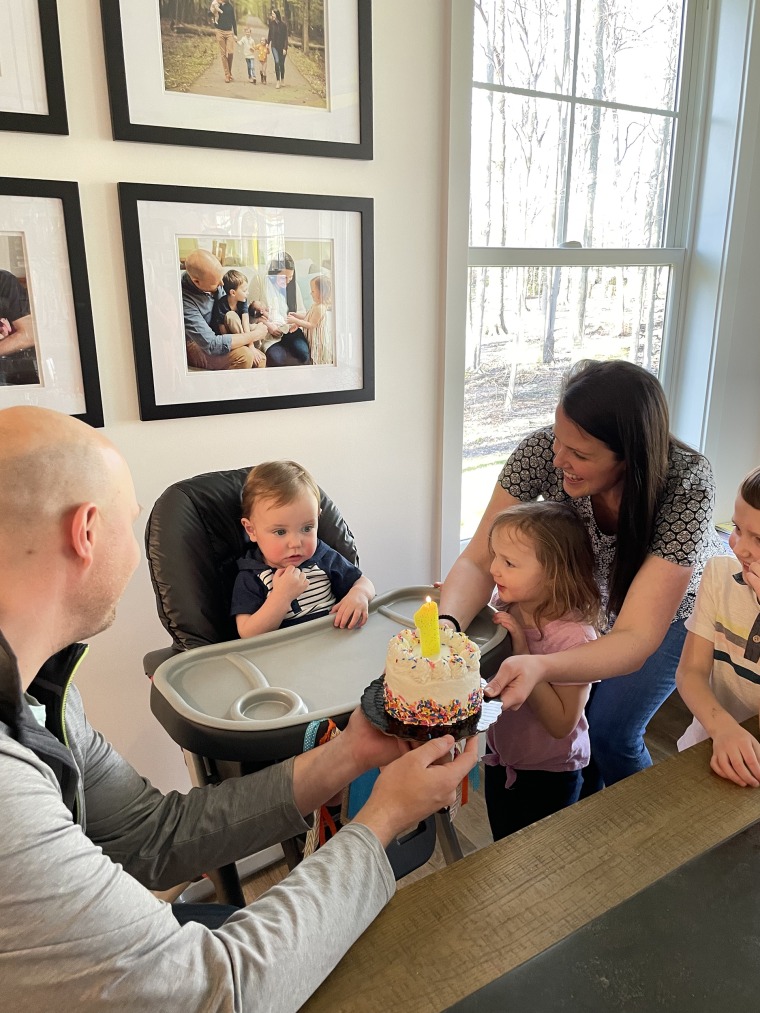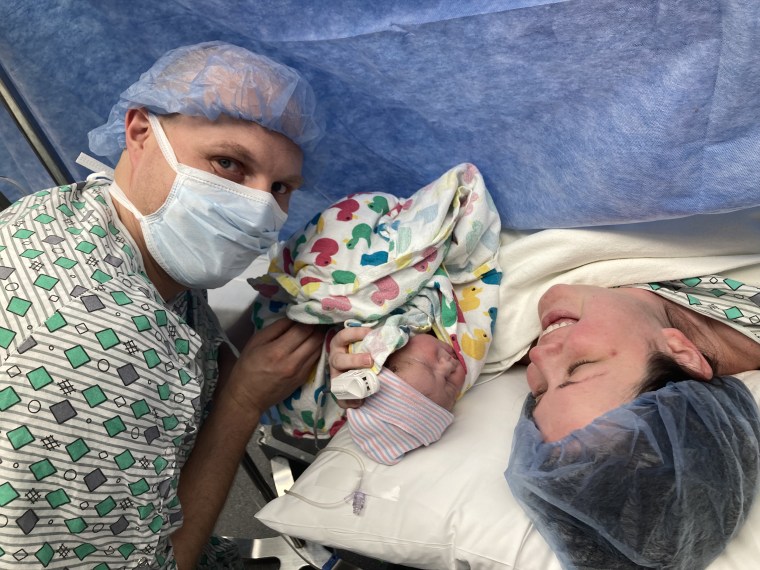For about a month during her pregnancy with her third child in 2020, Mallory Wehage experienced intense headaches and struggled to get out of bed.
“They were really like a searing painful headache that was always in the same spot of my head. It was behind my ear, to the back of my neck,” Wehage, 35, of Avon Lake, Ohio, told TODAY. “It was constantly in that same spot.”
Her OB-GYN sent her to a neurologist to undergo an MRI to make sure everything was OK. At the time, she was 22 weeks pregnant. She felt shocked when the doctor informed her of the results: She had a "giant brain aneurysm," or a bulging blood vessel in the brain, and she needed to go to Cleveland Clinic for care.
“I remember feeling a little bit of odd relief that there was a reason for why my head was hurting,” she said.
Headaches after exercise become devastating
The summer before Wehage became pregnant, she experienced headaches after she exercised.

“I just chalked it up to, 'I have two kids, I’m not sleeping well. I’m not drinking enough water,'” she recalled. “I wrote it off and went on with life not feeling great.”
But when she was pregnant, there were a few days she couldn’t get out of bed because of the intense headaches. She called the on-call nurse who prescribed a migraine medication to help ease the symptoms. At a followup, her OB-GYN felt worried by when Wehage reported still experiencing debilitating headaches with the medication.
“The headaches were still there,” Wehage said. “My doctor said, ‘This doesn’t sound like a normal pregnancy headache that some women get in their second trimester.'”
Her doctor recommended she see a neurologist, whom she met virtually the week before Christmas.
“She said, ‘Let’s do some scans.' We were going to rule out the bad things and then after that we (could) talk about pregnancy safe medications to address the headaches,’” Wehage recalled.
After she received an MRI on Jan. 6, 2021, Wehage returned home to lay down. The sound from the machine worsened her headache. That’s when the call came, informing her that she had a “giant” aneurysm, the size of a golf ball, nestled on the top of her brainstem. The bulging blood vessel could've burst at any moment, and she needed surgery.
“It was pushing on my brainstem, so it was really messing with how I was feeling all over,” she said. “Being pregnant, your body is changing. The symptoms were so heightened.”

While she felt relieved to have an answer, she also felt a little scared. But she remained level-headed for her children.
“I had to keep it together because I had a 4- and a 2-year-old at the time, and I didn’t want to scare them,” she said. “I was packing a bag, (and) my son was like, ‘Mom, it looks like you’re going to Mexico,’ and I was like, 'Yeah, I’ll be gone for a couple of days.’ At that time, we had no idea how long I would be gone or what was going to happen to the baby I was pregnant with.”
While Wehage waited for surgery, she was in the intensive care unit for monitoring. Forty-eight hours after discovering the aneurysm, Wehage underwent brain surgery.
“This part always makes me a little emotional: The very last thing they did before they put me under was have a labor and delivery nurse check the baby’s heartbeat,” she said. “The very first thing they did when they woke me up was check the baby’s heartbeat. So, the same nurse that did that came to visit me later when I was more with it, and the first thing I said to her when they woke me up was, ‘Am I still pregnant?’”

How common are brain aneurysms?
According to the Brain Aneurysm Foundation, about 6.5 million people in the United States live with an unruptured brain aneurysm, and each year about 30,000 people experience a rupture. In half of those cases, the rupture is fatal. Wehage visited her doctor because she had a headache, which is how doctors catch aneurysms before they burst in some cases.
“Some patients will have headaches as a warning sign beforehand,” Dr. Peter Rasmussen, a neurosurgeon at Cleveland Clinic, told TODAY. “But unfortunately, many don’t.”
People at risk for aneurysm include:
- Those with a family history of them
- Those with a history of stroke or previous brain aneurysm
- Those who smoke
- Those who do drugs, such as cocaine or amphetamines
- Those will unregulated high blood pressure
Some, like Wehage, develop them without having a risk factor. Doctors place aneurysms into categories: small, large and giant. Wehage’s was 27 millimeters, which is considered “giant.” She needed to have surgery to remove it immediately because of its size and her pregnancy could've worsened it.
“Giant aneurysms are very high risk for rupture, and then, of course, women, when they’re pregnant, they go through significant changes in their cardiovascular systems, and it’s not uncommon for the blood pressure to rise and the cardiac output to rise. And those things also add additional risk to the aneurysm bleeding,” Rasmussen said. “It was squashing her brainstem. ... That likely would have been life-ending if it ruptured.”

Rasmussen said it’s somewhat “miraculous” that Wehage didn’t experience any numbness or tingling in her legs or arms because of where the aneurysm was located. Wehage’s pregnancy made treating the aneurysm more difficult because she couldn't lie on her stomach for a long period of time. What’s more, they couldn't keep her under anesthesia for too long because that could also impact the fetus.
Fortunately, doctors were able to stop one of the arteries pumping blood into the aneurysm without stopping blood flow to her brain.
“For this particular aneurysm, the type of treatment we did is highly effective. There’s about 100% certainty that the aneurysm’s gone and will be permanently,” Rasmussen said. “Unfortunately, for patients who develop brain aneurysms, about 5 to 10% of them will develop new aneurysms.”
Every five years, Wehage will undergo scans to make sure no new aneurysms have developed.

Recovery and birth
When she woke up from her surgery, Wehage felt relieved that her baby was fine. At first, after the surgery, the aneurysm ballooned up before receding.
“My headaches were actually pretty intense. So, I was on a really high dose of steroids when I got home, which then was impacting my blood sugar, which for pregnancy is not ideal,” she said. “I had to take my blood sugar four times a day, and I had to use insulin before all my meals because of the steroids. So that made the rest of the pregnancy … high risk.”
Going into labor and pushing could be dangerous to her brain’s recovery so doctors wanted her to deliver via C-section. Grappling with gestational diabetes, the ongoing headaches and the idea of her first C-section felt tough. Then a 36-week scan indicated she had no amniotic fluid remaining.
“From that appointment, I had to go straight to the hospital and have the baby earlier than we had planned so that was a little shocking,” she said.
Scotty joined the family on April 12, 2021.
“He’s almost a year and a half, and you would never know that he was only 5 pounds when he was born,” she said. “He’s healthy, growing, busy. He’s great.”
Through her experience, Wehage learned how strong she was.
“It wasn’t just the baby I was pregnant with that I had to think about. It was also getting home for my kids and to be there as their mother,” she said.
Still, she regrets downplaying her headaches.
“I do wish I would have listened to my body more because that summer before I was even pregnant, there were signs that something wasn’t right. But I kept pushing through it when I should have made the time for myself to go to a doctor and get those headaches checked out,” she said. “The lesson to me is listen to myself, make time for myself.”
